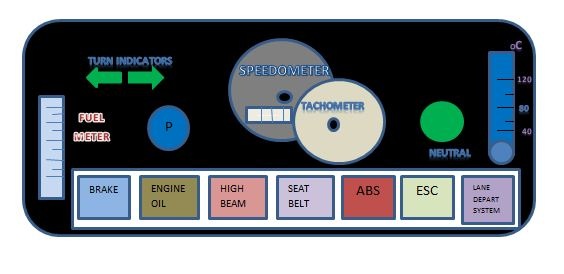Instrument Clusters
- Basic Description
-
The instrument cluster in a vehicle is generally located directly above the steering wheel and displays important vehicle operation information to the driver such as vehicle speed, fuel level and the status of various vehicular systems. This information is usually presented visually in the form of needle gauges, digital readouts and lighted symbols. The speedometer is usually the primary focus within the instrument cluster.
Most instrument clusters today consist mainly of needle gauges driven by stepper motors. These gauges along with all of the warning lights and displays are built into a single instrument cluster module. A processor controls most of these gauges and uses input from a variety of systems to make decisions about what to display. Most instrument clusters today also have some sort of digital multi-display which can be changed by inputs from the driver to show different information about the vehicle and allow the driver to change various settings.
In the 1990s, SAAB began to offer a “black panel” feature (supposedly derived from their aerospace division) that allowed the driver to disable any unnecessary instrumentation, activating and deactivating gauges based on which information was deemed most important. This idea of adapting the information presented to the driver has evolved significantly. Newer cars generally have some degree of a “Virtual Instrument Cluster” meaning they have digital displays that can be customized. Audi for example offers what they call “virtual cockpit” in their 2014 models, which combines the functions of a central multi-media interface monitor and a conventional instrument cluster into one LCD display. Drivers can select either classic view or infotainment view displaying things such as navigation and telephone.
Reconfigurable digital instrument clusters that visualize the information with a display have several advantages in comparison to analog clusters. Displayed information can be changed according to the drive mode (e.g. highway, off-road). This helps to reduce driver distraction by mainly displaying the information the driver requires in this situation. In addition, features can be implemented that allow the user to choose the information that is displayed. Automakers can benefit from using a digital cluster since they can integrate the same hardware in different vehicle lines by modifying the optical user interface only. The same flexibility enables the automakers to simply add functions to the cluster by changing the software but using the same hardware. All things considered, a freely reconfigurable monitor allows the integration of more information that is displayed in the driver's primary field of view. For instance, maps from the navigation system and camera images during maneuvering or night time driving can become part of the driver's focus of attention when needed.
There is also a movement to improve driver safety when interacting with the instrument cluster. Several instrument cluster manufacturers have integrated head-up display modules into the instrument cluster system that project the most vital information onto the windshield itself, allowing the driver to keep line of sight very close to the road ahead at all times. The freedom allowed through the new virtual clusters has also created opportunities for new safety systems—Delphi offers an “Exogenous Safety Warning System” That flashes the entire instrument display in the event of an emergency situation.
Future Instrument Clusters will most likely continue this trend of easy personalization and customizable information display. Several manufacturers are working to add portable device integration to the instrument cluster control, allowing cell phones and other portable devices to provide the driver with information through the instrument cluster. Side and rear view cameras may also be integrated into the display in the future, helping to eliminate blind spots and further improve driver safety.

Indicators commonly found in a passenger car instrument cluster
- Speedometer – indicates how fast the vehicle is moving
- Tachometer – indicates how fast the engine is turning
- Odometer – indicates how far the vehicle has traveled
- Fuel Gauge – indicates how much fuel is left in the vehicle
- Check engine light - indicates that a problem has occurred that requires maintenance
- Coolant temperature gauge – indicates the temperature of the engine coolant
- Gear Shift position – indicates which gear shift lever is in
- Seat Belt Warning – indicates if the driver and/or passengers have fastened their seat belts
- Oil pressure gauge – indicates the pressure of the engine oil
- Tire pressure monitoring system – indicates whether one or more tires has low pressure
- Sensors
- Wheel speed sensor, engine speed sensor, engine temperature sensors, tire pressure sensors, fuel-level
- Actuators
- Gauges, digital displays, speakers, buzzers, lights
- Data Communications
- CAN and LIN
- Manufacturers
-
Caerbont Automotive,
Calsonic Kansei,
Continental,
Delphi,
Denso,
id4motion,
Magneti Marelli,
Microvision,
NVidia,
Preh,
Protomatic,
S&T Motiv,
Visteon,
Yazaki
- For More Information
- [1] Electronic Instrument Cluster, Wikipedia.
- [2] Automotive Instrument Clusters Go Digital, 3D, Wayne Cunningham, CNET Reviews, May 19, 2009.
- [3] 2013 Fiat Abarth | EVIC Controls & Instrument Cluster, YouTube, Dec. 3, 2012.
- [4] 2012 Chevy Volt - "How to" Video - Instrument Cluster Display | Chevrolet, YouTube, Aug. 12, 2011.
- [5] 2013 BMW X3 - Instrument Cluster, YouTube, Oct. 25, 2012.
- [6] Cadillac ATS, SRX and XTS Standard Instrument Cluster, YouTube, Mar. 15, 2013.
- [7] Mercedes-Benz - Instrument Cluster, YouTube, Mar. 6, 2013.
- [8] MCar Tech : 2014 Lexus IS F-Sport's Gorgeous Gauges, YouTube, May 2, 2013.
- [9] 2014 Chevrolet Corvette Stingray Digital Dash Overview, YouTube, Aug. 12, 2013.
- [10] Nissan LEAF Instrument Panel - Car Reviews, YouTube, Sep. 29, 2014.
|

